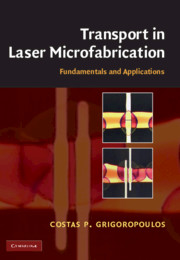Book contents
- Frontmatter
- Contents
- Preface
- 1 Fundamentals of laser energy absorption
- 2 Lasers and optics
- 3 Thermal processes in laser–materials interactions
- 4 Desorption at low laser energy densities
- 5 Dynamics of laser ablation
- 6 Ultrafast-laser interactions with materials
- 7 Laser processing of thin semiconductor films
- 8 Laser-induced surface modification
- 9 Laser processing of organic materials
- 10 Pulsed-laser interaction with liquids
- 11 Laser cleaning of particulate contaminants
- 12 Laser interactions with nanoparticles
- 13 Laser-assisted microprocessing
- 14 Nano-structuring using pulsed laser radiation
- Index
- References
9 - Laser processing of organic materials
Published online by Cambridge University Press: 04 December 2009
- Frontmatter
- Contents
- Preface
- 1 Fundamentals of laser energy absorption
- 2 Lasers and optics
- 3 Thermal processes in laser–materials interactions
- 4 Desorption at low laser energy densities
- 5 Dynamics of laser ablation
- 6 Ultrafast-laser interactions with materials
- 7 Laser processing of thin semiconductor films
- 8 Laser-induced surface modification
- 9 Laser processing of organic materials
- 10 Pulsed-laser interaction with liquids
- 11 Laser cleaning of particulate contaminants
- 12 Laser interactions with nanoparticles
- 13 Laser-assisted microprocessing
- 14 Nano-structuring using pulsed laser radiation
- Index
- References
Summary
Introduction
Laser ablation of polymers and other molecular materials constitutes the basis for a range of well-established applications, such as matrix-assisted laser desorption–ionization (MALDI) (Hillenkamp and Karas, 2000), laser surgery (Niemz, 2003) including the widely used laser-assisted in situ keratomileusis (LASIK) technique, surface microfabrication and lithography (Lankard and Wolbold, 1992), and pulsed laser deposition (PLD) of organic coatings (Bäuerle, 2000; Chrisey and Hubler, 1994). Interaction of UV laser pulses with an organic substance typically results in photothermal and/or photochemical processes in the irradiated material. Generally, photothermal processes, which produce heat in the sample, dominate when the laser photon energy is small, whereas photochemical processes occur when the laser photon energy is larger than the chemical-bond energies of the molecules.
For lasers operating at near-IR wavelengths, photothermal processes usually play a major role. With deep-UV (wavelength shorter than ∼200 nm) laser irradiation, in which the photon energy is larger than the typical energy of the chemical bonds of molecules, photochemical processes are usually responsible for the onset of ablation. For laser ablation of organic materials with wavelengths between the near IR and deep UV, photothermal and photochemical processes are often interrelated (Ichimura et al., 1994). On the other hand, the characteristics of material ejection depend on the nature of the ablation process (Srinivasan, 1986; Georgiou et al., 1998). For instance, ablation of organic materials results in little lateral damage in the sample when the photochemical processes are dominant.
- Type
- Chapter
- Information
- Transport in Laser MicrofabricationFundamentals and Applications, pp. 265 - 281Publisher: Cambridge University PressPrint publication year: 2009



